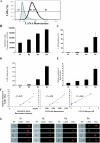Asynchronous progression through the lytic cascade and variations in intracellular viral loads revealed by high-throughput single-cell analysis of Kaposi's sarcoma-associated herpesvirus infection
- PMID: 17005685
- PMCID: PMC1617294
- DOI: 10.1128/JVI.01156-06
Asynchronous progression through the lytic cascade and variations in intracellular viral loads revealed by high-throughput single-cell analysis of Kaposi's sarcoma-associated herpesvirus infection
Abstract
Kaposi's sarcoma-associated herpesvirus (KSHV or human herpesvirus-8) is frequently tumorigenic in immunocompromised patients. The average intracellular viral copy number within infected cells, however, varies markedly by tumor type. Since the KSHV-encoded latency-associated nuclear antigen (LANA) tethers viral episomes to host heterochromatin and displays a punctate pattern by fluorescence microscopy, we investigated whether accurate quantification of individual LANA dots is predictive of intracellular viral genome load. Using a novel technology that integrates single-cell imaging with flow cytometry, we found that both the number and the summed immunofluorescence of individual LANA dots are directly proportional to the amount of intracellular viral DNA. Moreover, combining viral (immediate early lytic replication and transcription activator [RTA] and late lytic K8.1) and cellular (syndecan-1) staining with image-based flow cytometry, we were also able to rapidly and simultaneously distinguish among cells supporting latent, immediate early lytic, early lytic, late lytic, and a potential fourth "delayed late" category of lytic replication. Applying image-based flow cytometry to KSHV culture models, we found that de novo infection results in highly varied levels of intracellular viral load and that lytic induction of latently infected cells likewise leads to a heterogeneous population at various stages of reactivation. These findings additionally underscore the potential advantages of studying KSHV biology with high-throughput analysis of individual cells.
Figures




Similar articles
-
Full-Length Isoforms of Kaposi's Sarcoma-Associated Herpesvirus Latency-Associated Nuclear Antigen Accumulate in the Cytoplasm of Cells Undergoing the Lytic Cycle of Replication.J Virol. 2017 Nov 30;91(24):e01532-17. doi: 10.1128/JVI.01532-17. Print 2017 Dec 15. J Virol. 2017. PMID: 28978712 Free PMC article.
-
IFI16 recruits HDAC1 and HDAC2 to deacetylate the Kaposi's sarcoma-associated herpesvirus (KSHV) latency-associated nuclear antigen (LANA), facilitating latency.J Virol. 2025 Mar 18;99(3):e0154924. doi: 10.1128/jvi.01549-24. Epub 2025 Feb 10. J Virol. 2025. PMID: 39927772 Free PMC article.
-
Kaposi's sarcoma-associated herpesvirus-encoded latency-associated nuclear antigen inhibits lytic replication by targeting Rta: a potential mechanism for virus-mediated control of latency.J Virol. 2004 Jun;78(12):6585-94. doi: 10.1128/JVI.78.12.6585-6594.2004. J Virol. 2004. PMID: 15163750 Free PMC article.
-
ARID3B: a Novel Regulator of the Kaposi's Sarcoma-Associated Herpesvirus Lytic Cycle.J Virol. 2016 Sep 29;90(20):9543-55. doi: 10.1128/JVI.03262-15. Print 2016 Oct 15. J Virol. 2016. PMID: 27512077 Free PMC article.
-
Viral latent proteins as targets for Kaposi's sarcoma and Kaposi's sarcoma-associated herpesvirus (KSHV/HHV-8) induced lymphoma.Curr Drug Targets Infect Disord. 2003 Jun;3(2):129-35. doi: 10.2174/1568005033481150. Curr Drug Targets Infect Disord. 2003. PMID: 12769790 Review.
Cited by
-
Variable episomal silencing of a recombinant herpesvirus renders its encoded GFP an unreliable marker of infection in primary cells.PLoS One. 2014 Nov 17;9(11):e111502. doi: 10.1371/journal.pone.0111502. eCollection 2014. PLoS One. 2014. PMID: 25402328 Free PMC article.
-
Lipoteichoic acid (LTA) and lipopolysaccharides (LPS) from periodontal pathogenic bacteria facilitate oncogenic herpesvirus infection within primary oral cells.PLoS One. 2014 Jun 27;9(6):e101326. doi: 10.1371/journal.pone.0101326. eCollection 2014. PLoS One. 2014. PMID: 24971655 Free PMC article.
-
Tracking expression and subcellular localization of RNA and protein species using high-throughput single cell imaging flow cytometry.RNA. 2012 Aug;18(8):1573-9. doi: 10.1261/rna.033126.112. Epub 2012 Jun 28. RNA. 2012. PMID: 22745225 Free PMC article.
-
Rapamycin blocks production of KSHV/HHV8: insights into the anti-tumor activity of an immunosuppressant drug.PLoS One. 2011 Jan 14;6(1):e14535. doi: 10.1371/journal.pone.0014535. PLoS One. 2011. PMID: 21264294 Free PMC article.
-
Rainbow Kaposi's Sarcoma-Associated Herpesvirus Revealed Heterogenic Replication with Dynamic Gene Expression.J Virol. 2020 Mar 31;94(8):e01565-19. doi: 10.1128/JVI.01565-19. Print 2020 Mar 31. J Virol. 2020. PMID: 31969436 Free PMC article.
References
-
- Asahi-Ozaki, Y., Y. Sato, T. Kanno, T. Sata, and H. Katano. 2006. Quantitative analysis of Kaposi sarcoma-associated herpesvirus (KSHV) in KSHV-associated diseases. J. Infect. Dis. 193:773-782. - PubMed
-
- Ballestas, M. E., P. A. Chatis, and K. M. Kaye. 1999. Efficient persistence of extrachromosomal KSHV DNA mediated by latency-associated nuclear antigen. Science 284:641-644. - PubMed
-
- Barbera, A. J., J. V. Chodaparambil, B. Kelley-Clarke, V. Joukov, J. C. Walter, K. Luger, and K. M. Kaye. 2006. The nucleosomal surface as a docking station for Kaposi's sarcoma herpesvirus LANA. Science 311:856-861. - PubMed
-
- Canham, M., and S. J. Talbot. 2004. A naturally occurring C-terminal truncated isoform of the latent nuclear antigen of Kaposi's sarcoma-associated herpesvirus does not associate with viral episomal DNA. J. Gen. Virol. 85:1363-1369. - PubMed
-
- Chandran, B., C. Bloomer, S. R. Chan, L. J. Zhu, E. Goldstein, and R. Horvat. 1998. Human herpesvirus-8 ORF K8.1 gene encodes immunogenic glycoproteins generated by spliced transcripts. Virology 249:140-149. - PubMed
Publication types
MeSH terms
Substances
Grants and funding
LinkOut - more resources
Full Text Sources
Other Literature Sources
Research Materials
Miscellaneous

